Review: For Desert X 2019, I drove 198 miles to see 19 artists’ work. Here’s the best
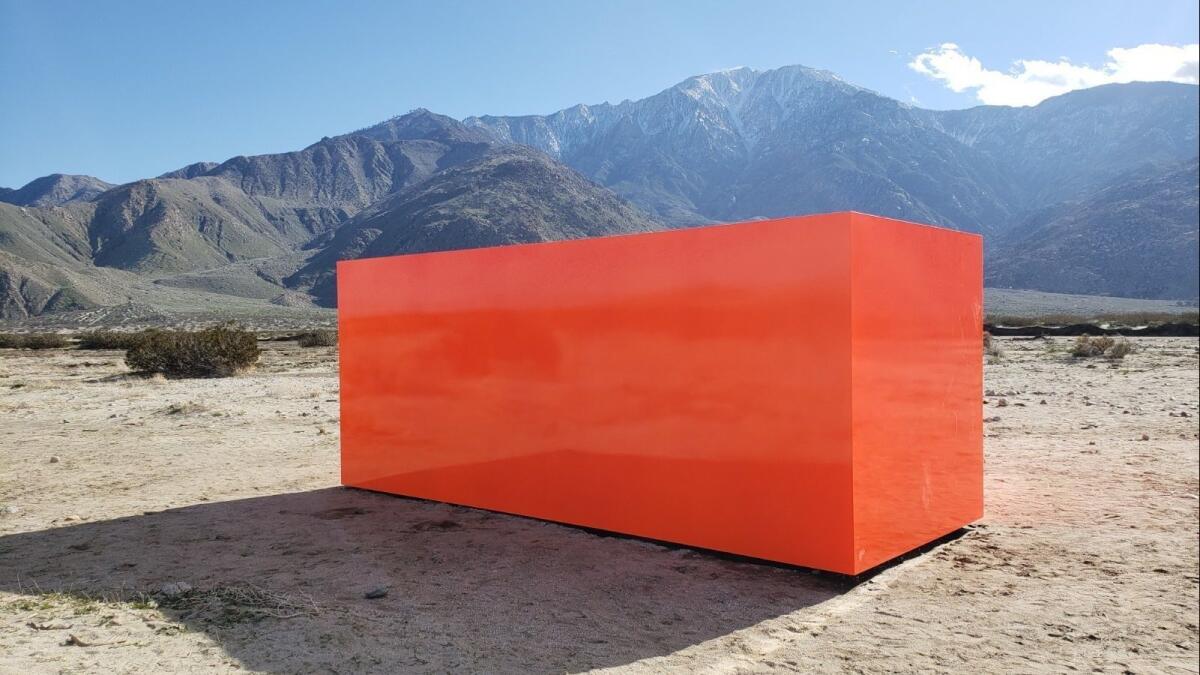
- Share via
Reporting from Palm Springs — It has been an unusually wet winter in the Coachella Valley. Nearly a year’s worth of rain fell in the first six weeks of 2019, while a mega-storm crashed through on Valentine’s Day — the wettest desert day recorded in 76 years.
Apocalyptic flooding closed roads, blocked freeway exit ramps, shut down the aerial tram, clogged the washes with mud and shuttered businesses. The desert and foothills are now startlingly green, the mountain tops blanketed in lovely white snow.
So it is fitting that Irish artist John Gerrard has raised his climate change flag.
Near the Palm Springs Visitors Center at the city’s entrance, a massive digital screen erected in the desert melds fossil fuels with state and national emblems as part of the second installment of Desert X, a valley-wide biennial exhibition of preexisting and commissioned public art. The screen image shows the flat, exhausted field near Beaumont, Texas, where the first colossal geyser of oil was drilled in 1901 from 1,000 feet below the surface.

Spindletop, as the generative event in the explosive fossil-fuel business was called, fed America’s accelerating transition from an agrarian to an industrial powerhouse. Gerrard has digitally animated the scene, adding a new spindle in the center of the virtual landscape — a tall flag pole, its fluttering banner a streaming cloud of thick, black smoke.
The augmented reality work was commissioned by British public television for Earth Day 2017. Can it be an accident that the artist made it in the year that saw Texas oilman Rex Tillerson named U.S. Secretary of State? “Western Flag” is the conceptual axis around which all else turns: Erased is the democratic promise held in the red, white and blue of the U.S. and Texas state banners — and the Union Jack — subsumed into the relentless flows of soot and carbon-emissions.
Farther out on Highway 111, closer to Interstate 10, sculptor Sterling Ruby has erected an abstract caution sign in another vast field of desert scrub. A massive, rectangular steel box, its shape echoes the freight cars rumbling by on train tracks in the distance. Ruby has painted the sculpture, titled “Specter,” a flaming orange, the same eye-grabbing hue of emergency traffic cones and safety vests.
In the approach on foot from the roadside parking turnoff, the top edge of the intractable, horizontal monolith lines up with the massive mountains behind it, squaring off their natural meander. The isolated fusion of minimalist form and maximalist color, flashy but mute, performs a seemingly impossible engineering feat for such sculptural tonnage in so hostile an environment.

FRIEZE LOS ANGELES: The critic’s take on the art fair’s inaugural year in Hollywood »
Fifty-seven miles to the east is the Salton Sea, an enormous, shallow, accidentally created lake — the largest inland body of water in California — spreading out across the San Andreas fault. Near a beach and yacht club, Nancy Baker Cahill has produced an equally compelling work. “Margin of Error” wedges itself between Gerrard’s digital wizardry and Ruby’s cautionary specter.
Visitors are instructed to download an app onto a phone or tablet before leaving home. Arrive at the site, hold the mobile device aloft and log on. Follow the screen’s pointing arrow and an apparition soon appears: A twirling, swirling fog of phantasmagorical shards of light and shadow hovers in the sky above the lake.
Cahill’s virtual art-churn conjures a descendant of Mark Rothko’s pivotal 1944 painting, “Slow Swirl at the Edge of the Sea,” harbinger of the imminent Abstract Expressionist revolution to come. Hers could be a star being born from a cloud of dust, or perhaps a plague of locusts descending on the area’s fertile farmland. Maybe it illustrates a thought forming. Among the most haunting virtual artworks I’ve seen, it heralds an uncertain future.
Rothko also lingers within Argentinian artist Cecilia Bengolea’s sculptural bestiary, “Mosquito Net,” a few hundred yards away. Cutouts of hybrid animal-people dance in the odoriferous water quietly lapping against the squishy shoreline.
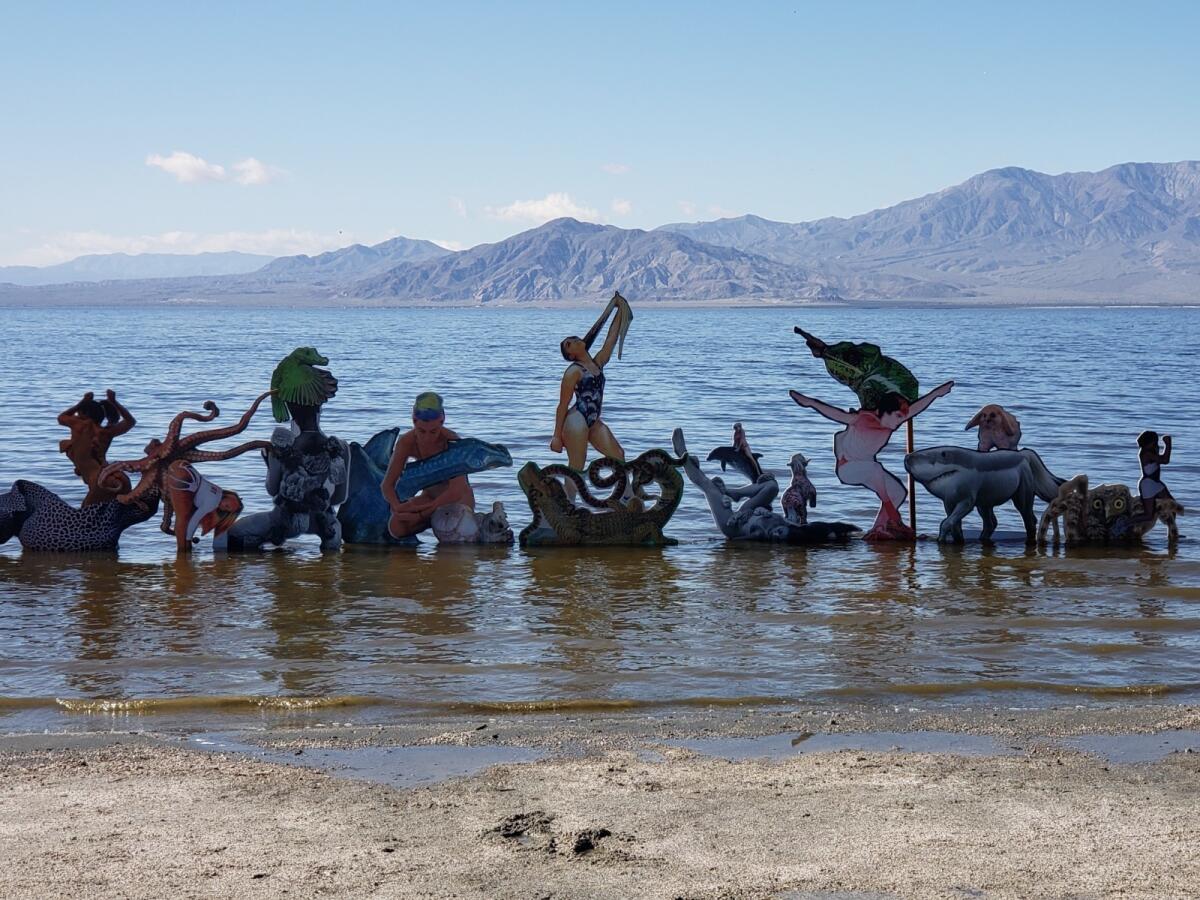
The mileage between the works by Gerrard and Ruby and those by Cahill and Bengolea is a drawback for out-of-town visitors to Desert X. It works for locals, who have until April 21 to take it all in. But in the two packed days I spent traversing the 16 artists’ and three artist-collectives’ works, I drove 198 miles.
Had Jenny Holzer’s planned text-projection on a waterfall in the gorgeous Whitewater Preserve not been pulled — bighorn sheep in the vicinity have been afflicted with a mysterious virus, which made their behavior erratic — another 19 miles would have been added. The desert is big, but that’s a lot of ground to cover. Visiting should be more pleasure and less chore.
Coupled with several ticketed or sporadic works — performances by Bengolea, a sound work in a private house by Postcommodity (Cristóbal Martínez and Kade L. Twist), Gary Simmons’ occasional music program on a makeshift soundstage, films by the Danish collective Superflex at a coral-pink architectural structure that’s like a giant fish-tank ornament for the once (and future?) seabed that is the Coachella Valley — no one will see it all.
The road to Armando Lerma’s Coachella mural was closed, a special pity since his work was a highlight of the inaugural Desert X. (Lerma, who lives in the town, is the only artist to participate in both installments.) Cinthia Marcelle’s “Wormhole,” a chain of video surveillance links leapfrogging through six empty, far-flung storefronts, was out of order.
(Incidentally, if you have an iPhone, get the location app, designed by Palm Desert high schooler Hunter Martin, to find the installations; otherwise check the Desert X website to get a booklet, which has a printed map and GPS coordinates.)
Curators Neville Wakefield, Amanda Hunt and Matthew Schum have mostly chosen well, and several good projects are grouped in relative proximity.
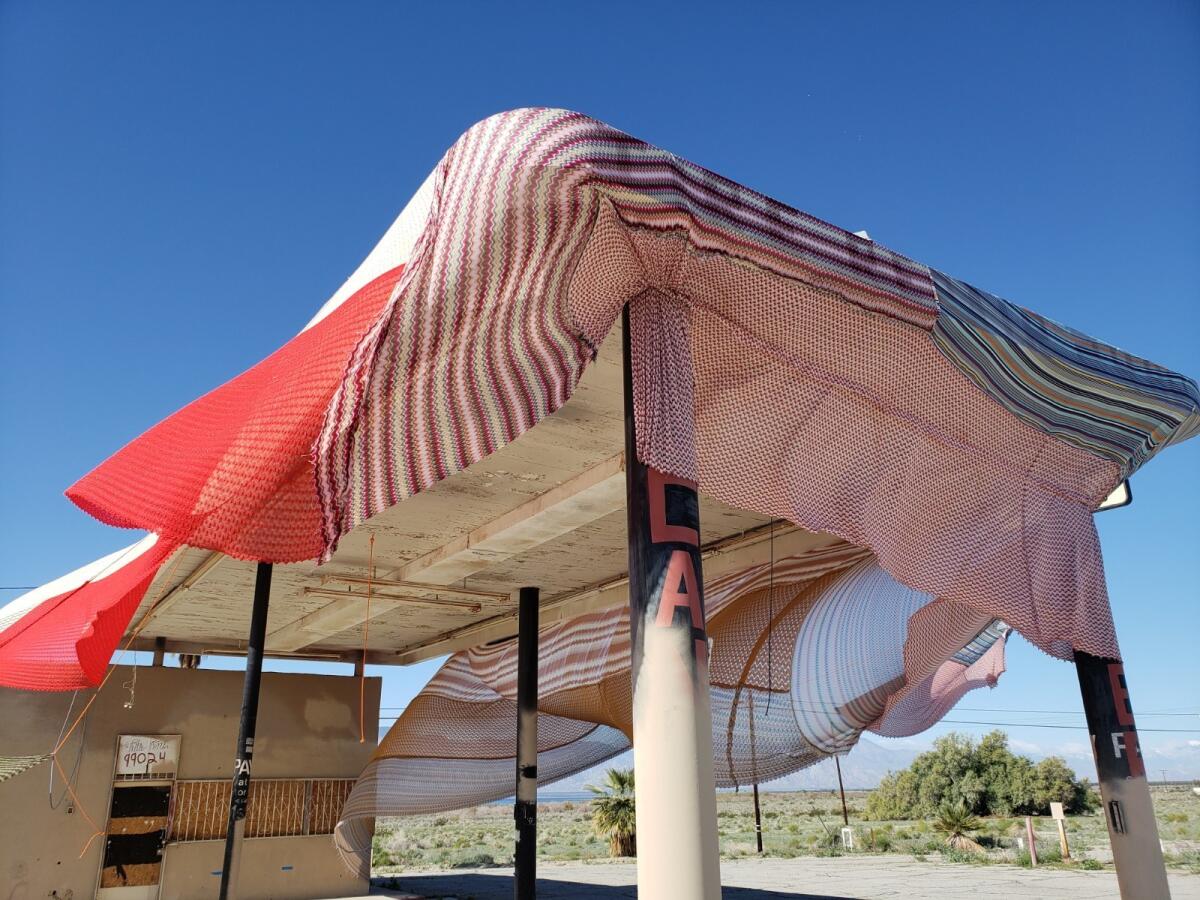
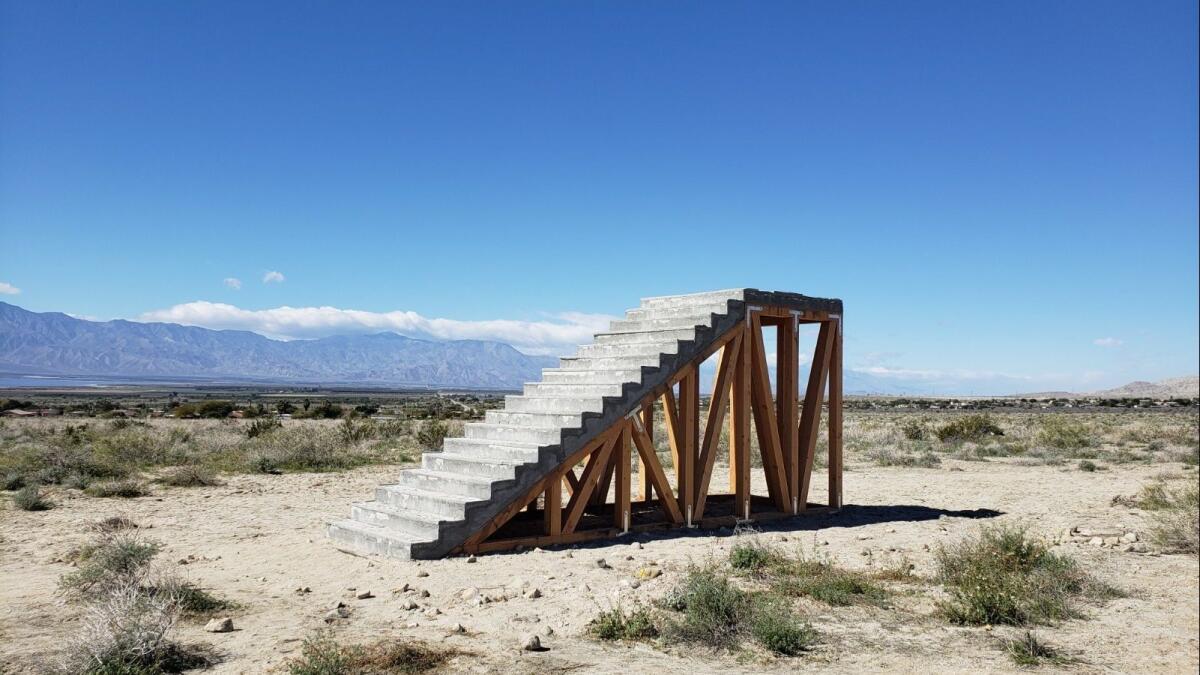
Also at the Salton Sea, Eric N. Mack wrapped the roofline of an abandoned auto-repair shop with a wonderfully eccentric “skirt” of wildly patterned Missoni fabrics. Flapping in the wind, “Halter” ups the ante on the homey local habit of draping cloth from patio awnings and car ports in search of relief from the relentless desert sun. Like torn stockings after a long night on the town, Mack’s blowsy installation feels exhausted, forlorn but happy to be here.
Up a hill, a circle of five sturdily built stairways by Iván Argote, a Colombian expatriate to France, leads a climber to scenic overlooks facing every which way. Everything from the sparkly lake to a grim march of electrical power lines comes into distant view. The stair treads sport short prose poems in Spanish and English, the stepped forms suggesting a Mesoamerican temple site made modern.
Two sculptures are in the town of Desert Hot Springs, north of Interstate 10. Both are wonderfully odd.
In an arroyo, Kathleen Ryan re-created a big fan palm, more than 20 feet tall, in light-scattering plastic on a steel trunk. Beneath its feathery fronds, already a bit worse for wear from harsh winter storms, a tiered skirt of clear-acrylic rods clatters like a noisy wind chime. Ryan’s “Ghost Palm” is Palm Springs chic — the unlikely offspring of a forced marriage between nature and Midcentury Modern furniture design.
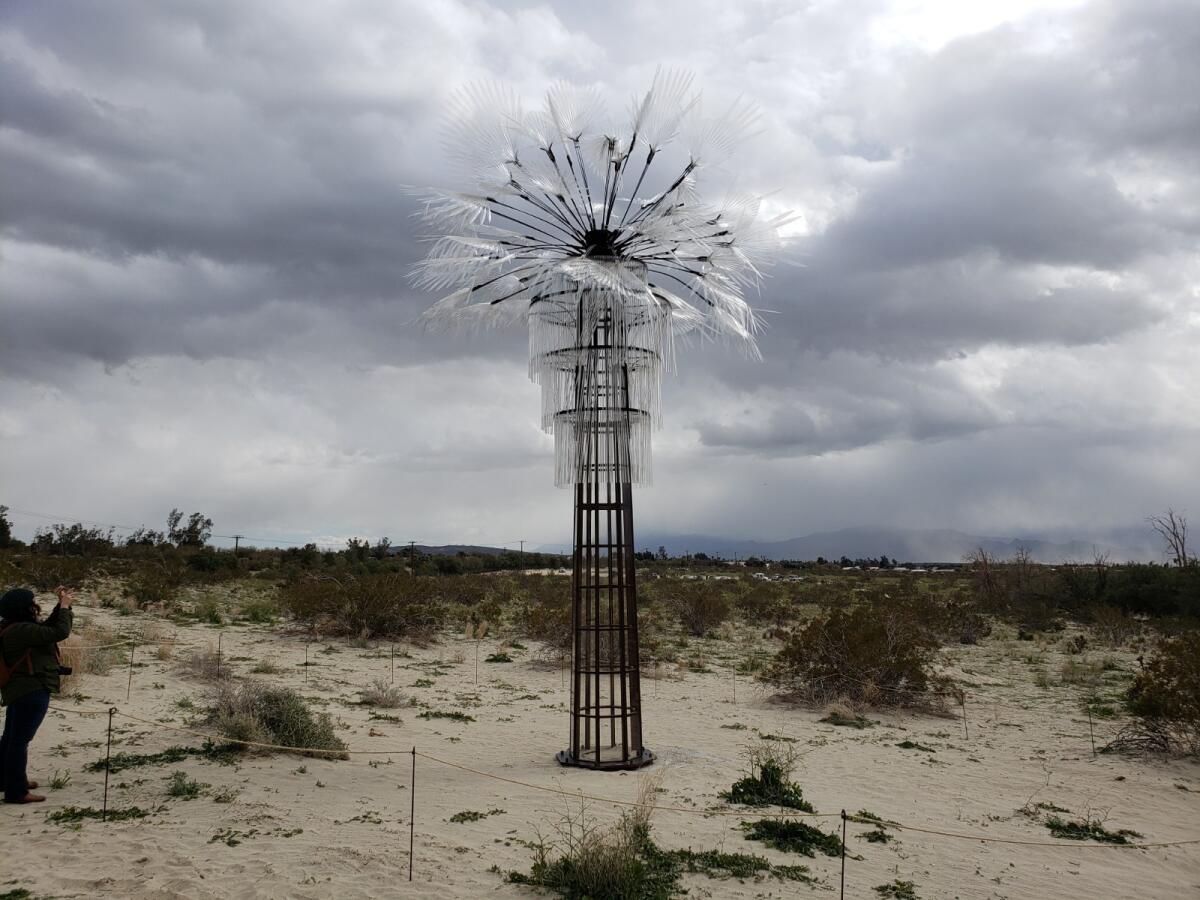

A splendid walled pavilion made from reddish concrete blocks by Julian Hoeber follows the contour of a Möbius strip, the random pattern of holes in the blocks further confounding the form’s visual perplexity. Walk the wall’s periphery and the path goes inside and outside and back again in one continuous, seemingly impossible loop.
A surfeit of hot springs spas and nondenominational Bible churches, both promising relief from life’s daily stresses, defines the neighborhood of “Going Nowhere Pavilion #01.” Hoeber’s witty secular shrine to the pesky mind-body conundrum throws the site into high relief. To underscore: A nearby gate leads to an empty swimming pool in an adjacent backyard, the artist’s self-portrait bust lying at the bottom poised to go down the drain.
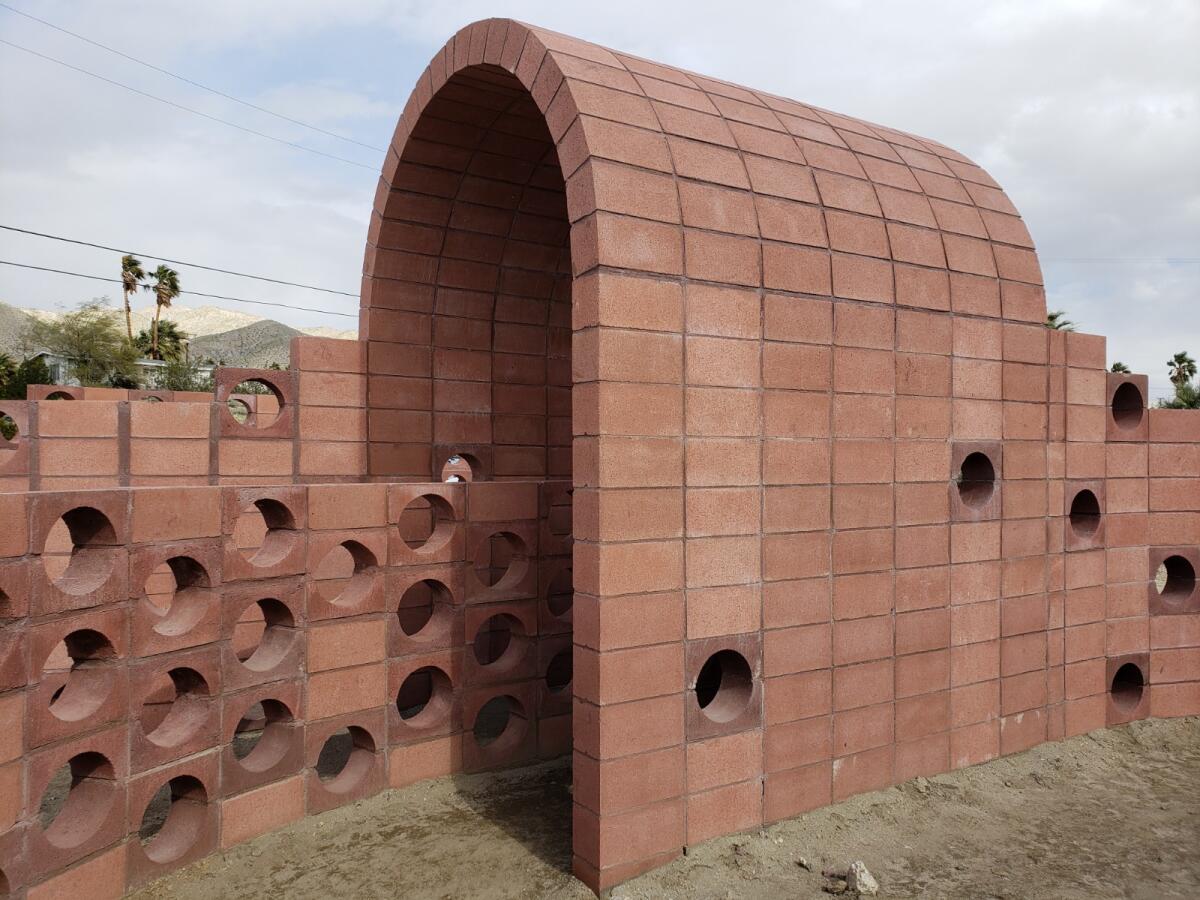
Projects by Pia Camil, Iman Issa, Mary Kelly, Cara Romero and the team of Steve Badgett and Chris Taylor are also on view. Happily, the gender disparity that blunted the 2017 inaugural has been largely repaired: All three participating artist-collectives are male, but nine of the 16 individual artists are women. With two unusually strong outings under its belt, look for a third Desert X to materialize in 2021.
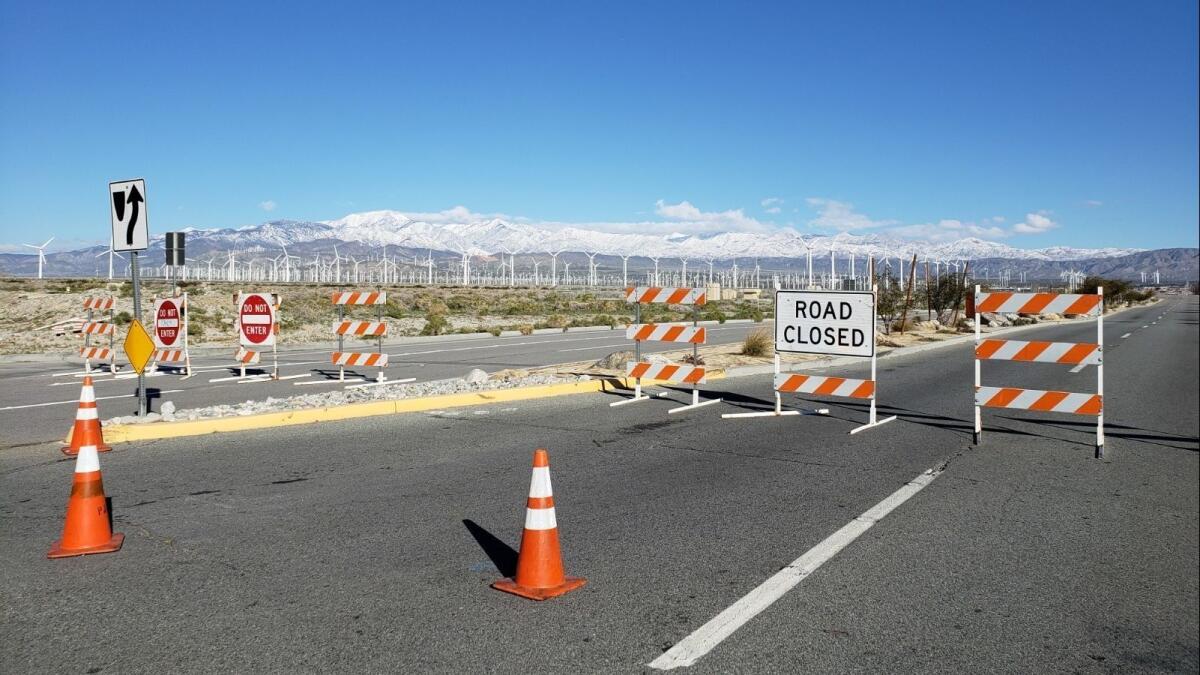
♦ ♦ ♦ ♦ ♦ ♦ ♦ ♦ ♦ ♦
Desert X
Where: Various sites in the Coachella Valley; guidebook and map at Ace Hotel, 701 E. Palm Canyon Drive, Palm Springs; 73660 El Paseo, Palm Desert; and 82713 Miles Ave., Indio.
When: Through April 21
Information: desertx.org
More to Read
The biggest entertainment stories
Get our big stories about Hollywood, film, television, music, arts, culture and more right in your inbox as soon as they publish.
You may occasionally receive promotional content from the Los Angeles Times.











